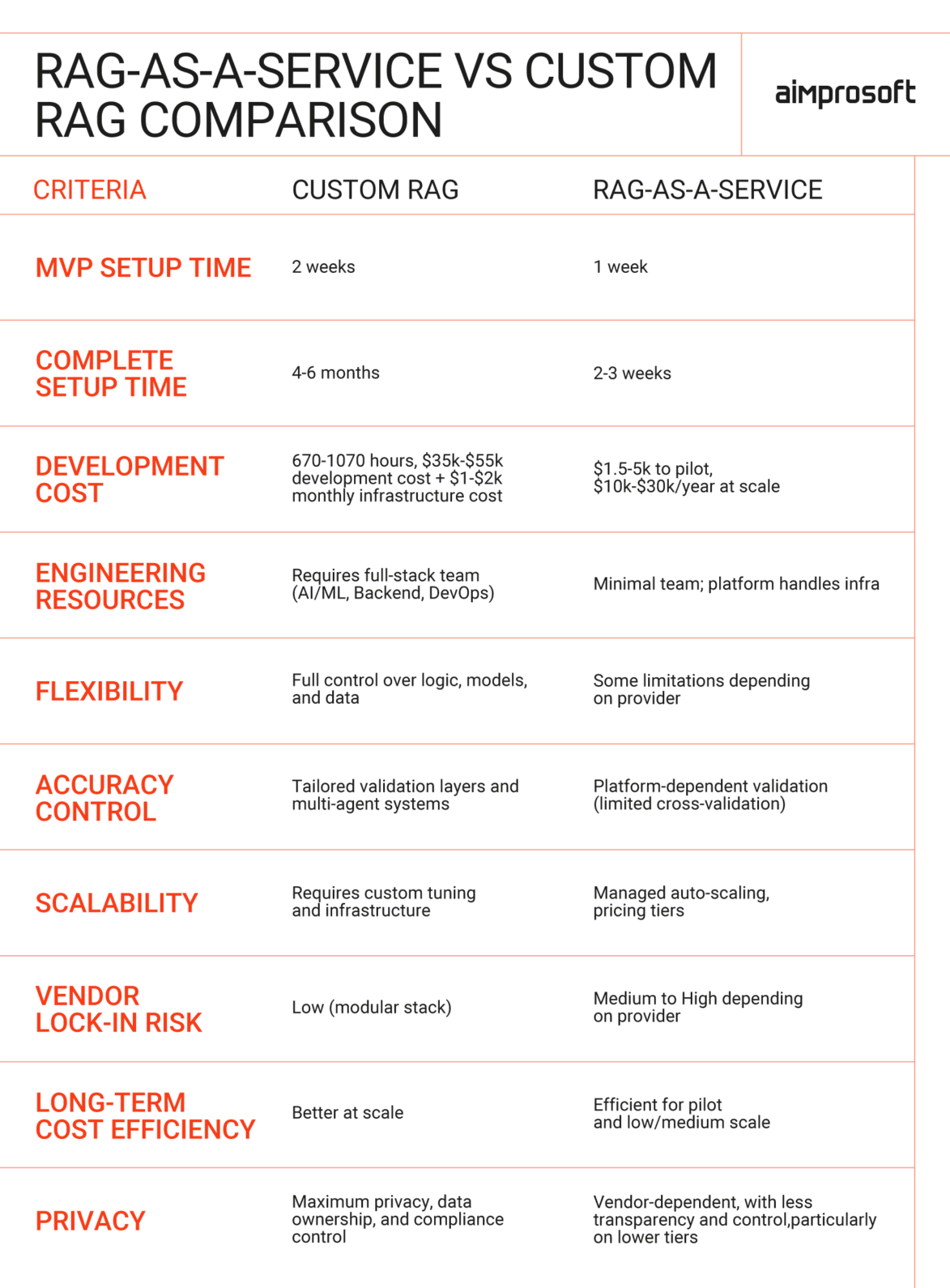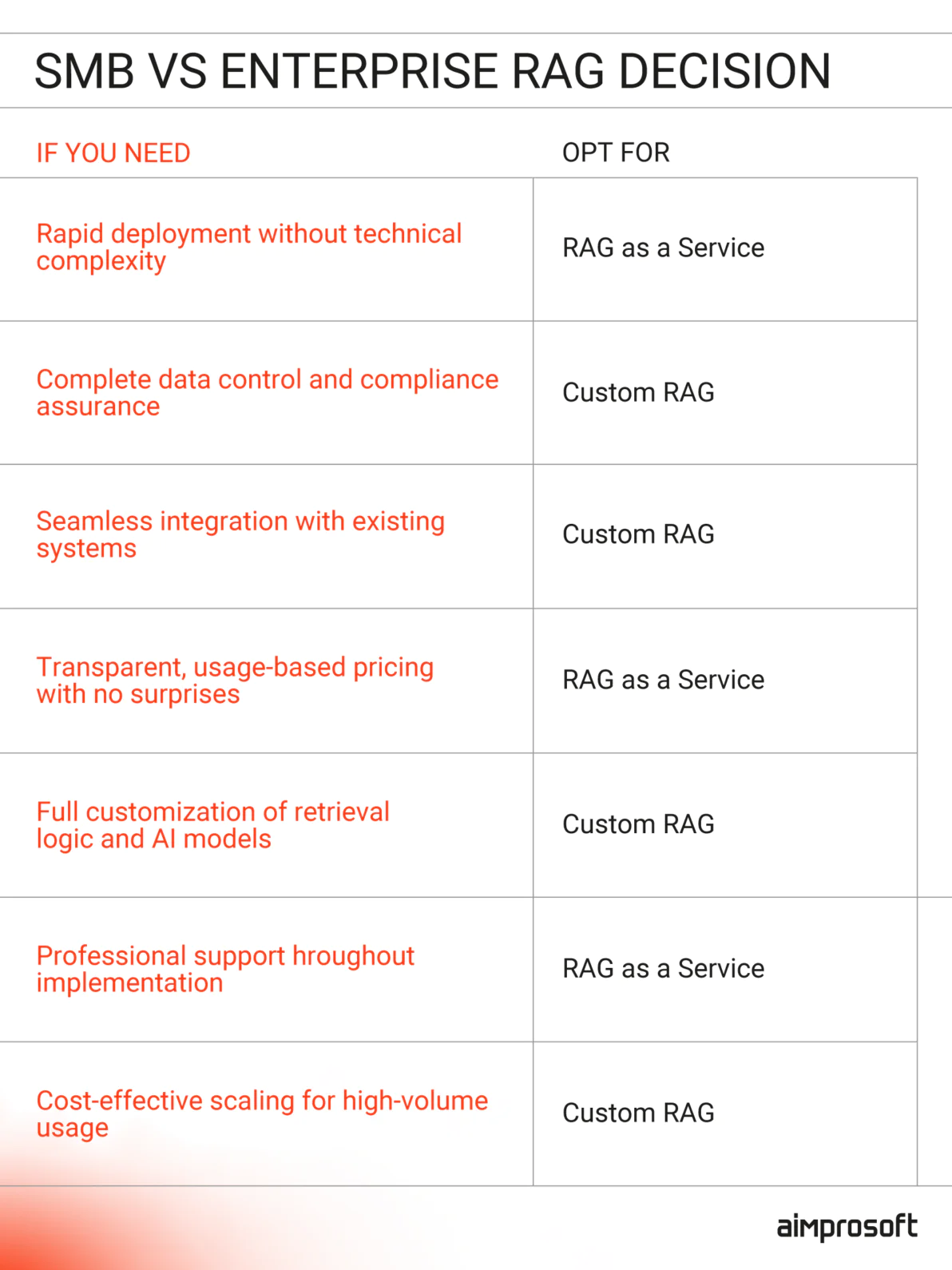RAG as a Service vs Custom RAG: Which Approach Fits Your Business?
If a 5-10-person legal firm and a Fortune 500 retailer both need document search capabilities, should they choose the same RAG solution? Logic says no. Their needs couldn’t be more different in terms of scale, customization, and resources.
Yet most articles on custom RAG and managed RAG reduce the decision to a straightforward build vs buy RAG debate when the reality is far more nuanced.
Here’s how this played out in practice: The legal firm evaluated custom RAG development for three weeks before choosing a managed RAG service—they’re now processing client documents 10x faster. The retailer rejected every RAGaaS platform and built their own system—six months later, their custom RAG AI solution handles 100M+ product queries daily.
Same technology. Different RAG implementation strategies. Both winning.
In this article, we’ll break down the key differences between RAG as a service and custom RAG, when each approach makes sense, and how to evaluate response quality regardless of which path you choose. Let’s dig in.
Choosing between RAG-as-a-Service and custom RAG
Before we get into comparisons, let’s pin down the basics: What is RAG as a service, and how does it differ from custom RAG?
RAG-as-a-Service (often shortened to RAGaaS) is the “buy” option in the classic RAG build vs buy decision. Instead of engineering your own retrieval-augmented generation pipeline from scratch, you subscribe to a managed service that handles heavy lifting.
A RAG-as-a-Service platform comes with ready-made components—retrievers, vector storage, and generation endpoints—that can be set up in just a few steps. You upload your data, adjust retrieval settings, and get back an API endpoint you can plug into your application.

The custom RAG development means building your own RAG system design from components—choosing your vector databases for RAG, designing and building RAG pipelines, and managing the entire AI infrastructure solution in-house. This approach gives you complete control over RAG architecture but comes with significant AI infrastructure requirements, plus a team capable of managing them effectively.
RAG-as-a-Service vs Custom RAG Comparison
The differences between custom RAG and RAG-as-a-Service are clear when you compare setup times, costs, resources, scalability, and privacy. But numbers alone don’t decide the “right” path. The same trade-offs look very different depending on your size, priorities, and risk tolerance.
That’s why it makes sense to look at the decision through two lenses: SMBs and enterprises.

SMB vs Enterprise: Different perspectives, different requirements
Small and medium businesses approach RAG adoption with a different mindset than large enterprises. For SMBs, the biggest pressure is speed. Choosing between build vs buy RAG, most lean toward buying—RAG as a service platforms offer managed RAG service with ready-to-use RAG pipeline components. This allows small teams to skip building RAG pipelines and focus on results. Predictable subscription pricing also shields them from unpredictable AI infrastructure requirements. For them, retrieval augmented generation as a service feels less like managing a system and more like plugging into a custom AI solution that delivers immediate benefits of RAG for businesses.
Enterprises face a different reality. Here, the RAG-as-a-service vs custom decision often tips toward custom RAG AI. Compliance, data governance, and integration with existing enterprise LLM solutions push them toward RAG system design managed in-house. This means choosing vector databases for RAG, managing scalable AI architecture, and making sure the custom RAG approach supports private RAG deployment—in other words, running the system entirely within your own infrastructure rather than on a shared platform.
Unlike SMBs, large organizations see RAG as part of their long-term AI adoption in enterprise strategy, optimizing RAG scalability, setting RAG performance benchmarks, and aligning with business standards.

For teams choosing RAG-as-a-Service as the faster route, the next step is selecting the right provider. Things like how reliable their API is, where they store your data, and how easily it plugs into your existing systems are crucial factors. To help with that choice, we’ve evaluated the leading RAG-as-a-Service providers side-by-side in our top 5 RAG-as-a-Service platforms comparison.
How to evaluate RAG performance
Whether you go with RAG-as-a-Service or custom RAG, you’ll need to evaluate both your tool choices and system performance. RAG tools comparison helps you pick components, but the bigger challenge is measuring real-world effectiveness.
In high-stakes industries like finance, healthcare, or legal, a single hallucination or misinterpreted document can trigger serious business or compliance consequences. Subject-matter experts provide essential human oversight, but you also need automated systems that verify accuracy, relevance, and consistency at scale.
When conducting RAG frameworks comparison for your organization, the following three approaches have proven most effective for ensuring RAG system performance metrics meet business-critical standards.
- RAGAS (Retrieval Augmented Generation Assessment) – For accuracy and business visibility.
Non-technical teams can use RAGAS to systematically measure whether answers are relevant, accurate, and properly sourced. Setup requires one-time developer configuration, then business users can run evaluations independently. RAGAS works with any RAG system and provides clear metrics that executives can understand: “85% of answers are factually grounded” rather than vague “it seems better.”
Outcome: Simple accuracy scores and actionable reports on system weaknesses.
- Giskard – For compliance and risk assurance.
Essential for regulated industries where you need to prove your system doesn’t discriminate or produce biased results. Requires technical integration into your RAG pipeline but runs automatically once configured. Giskard automatically tests thousands of scenarios to find edge cases where your RAG system might fail – like producing different answers for the same question asked by different user groups.
Outcome: Audit-ready compliance reports proving your system meets regulatory standards.
- SCARF (Scalable, Controllable, Accurate, Reliable, Fast) – For performance and optimization.
Requires ongoing technical team involvement to monitor performance across all dimensions. Best for teams with technical resources who need to optimize system performance. SCARF helps developers identify bottlenecks and trade-offs in custom RAG implementations. For example, it can show how response times slow down as you add millions of documents – helping teams decide whether to add more processing power or optimize their retrieval logic.
Outcome: Performance optimization data that justifies technical decisions and reduces operational costs.
In practice, many teams combine these frameworks based on their enterprise RAG solutions comparison needs: RAGAS for continuous accuracy tracking, Giskard for compliance when required, and SCARF for deep technical optimization. You don’t need all three immediately — pick the one that solves your biggest pain point first, then layer in others as your needs evolve.
When RAG implementations hit roadblocks
Implementing a RAG system requires ongoing attention, not just a one-time setup. Even with the right platform choice and solid early results, systems face pressure as workloads grow, requirements shift, and teams rely on them more heavily. What looks stable today can slowly erode without careful monitoring.
This decline happens in predictable ways rather than sudden crashes. Catching problems early is what separates long-term success from costly projects that fizzle out.
- Performance degradation over time: Initial RAG results seem promising, so teams skip rigorous evaluation. Months later, users report inconsistent answers, but the system is now deeply integrated. Left unchecked, this erodes trust and undermines ROI on your RAG investment. To prevent this from happening to your custom AI solution, monitor response times and accuracy monthly using tools like SCARF. Set performance thresholds that trigger infrastructure reviews before users notice problems.
- Unexpected cost escalation: Whether through RAGaaS usage spikes or custom infrastructure scaling needs, costs can quickly exceed budgets, forcing difficult choices between cutting features or overrunning budgets. This potentially stalls other AI initiatives and forces teams into reactive mode. To ensure this doesn’t happen, implement cost monitoring and set spending alerts. For custom RAG, budget for 2-3x initial infrastructure estimates. For RAGaaS, negotiate volume discounts upfront.
- Vendor limitations discovered late: RAGaaS platforms may lack specific features needed for compliance or integration, which are often discovered only after significant implementation. This oversight can cause delays in product launches, require expensive rebuilds, or force compromises on critical requirements. In order to stop this, create a requirements checklist covering compliance, integration, and customization needs before selecting any platform. Test edge cases during pilot phases.
None of these challenges has to be fatal if caught early. The strongest teams embed monitoring from day one and design migration paths between approaches. This approach prepares you for the future of RAG systems, which will inevitably require adaptation as technology and business needs evolve. This isn’t pessimism – it’s protecting your investment by staying flexible.
Making your RAG implementation decision
RAG projects usually stumble not because the technology is weak, but because teams get stuck in drawn-out evaluations, over-engineered pilots, or vendor choices that don’t align with long-term needs.
When your RAG approach is right, this is what you get:
- Evaluation cycles shrink from months to weeks because you focus on the factors that truly matter.
- Pilots reach production with clear ownership and measurable outcomes.
- Scaling happens systematically instead of through reactive fixes.
- Costs stay predictable because trade-offs are clear from the start.
So how do you actually get to that “right RAG” state? It comes down to three key implementation decisions: focusing evaluations on the right quality metrics, structuring pilots with success criteria and ownership, and choosing an architecture that matches your data and scaling requirements.
At Aimprosoft, we help teams make these decisions through our AI development services. Whether that means adopting a RAG-as-a-Service platform, building a custom system, or combining both approaches, we focus on practical outcomes that fit your constraints.
With the right support, RAG adoption stops being a question mark and becomes a competitive edge that compounds over time




